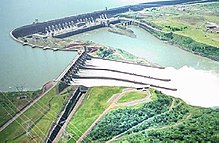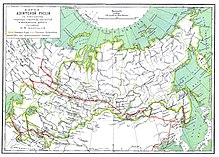

A megaproject is an extremely large-scale construction and investment project. A more general definition is "Megaprojects are temporary endeavours (i.e. projects) characterised by: large investment commitment, vast complexity (especially in organisational terms), and long-lasting impact on the economy, the environment, and society".
Megaprojects refer not only to construction projects but also decommissioning projects, which are projects that can reach multi-billion budgets, and have a high level of innovation and complexity, and are affected by a number of techno-socio-economic and organizational challenges.
The OFCCP Mega Construction Project (Megaproject) Program involves projects valued at over $35 million.
Downsides
Megaprojects are often affected by corruption, leading to higher cost and lower benefit.
According to the European Cooperation in Science and Technology (COST), megaprojects are characterized both by "extreme complexity (both in technical and human terms) and by a long record of poor delivery". Megaprojects attract significant public attention because of substantial impacts on communities, environment, and budgets, and the high costs involved. Megaprojects can also be defined as "initiatives that are physical, very expensive, and public".
Examples
Main articles: List of megaprojects and List of transport megaprojectsMegaprojects include special economic zones, public buildings, power plants, dams, airports, hospitals, seaports, bridges, highways, tunnels, railways, wastewater projects, oil and natural gas extraction projects, aerospace projects, weapons systems, information technology systems, large-scale sporting events and, more recently, mixed use waterfront redevelopments; however, the most common megaprojects are in the categories of hydroelectric facilities, nuclear power plants, and large public transportation projects. Megaprojects can also include large-scale high-cost initiatives in scientific research and infrastructure, such as the sequencing of the human genome, a significant global advance in genetics and biotechnology.
Rationale
The logic on which many of the typical megaprojects are built is collective benefits; for example electricity for everybody (who can pay), road access (for those that have cars), etc. They may also serve as a means to open frontiers. Megaprojects have been criticised for their top-down planning processes and their ill effects on certain communities. Large scale projects often advantage one group of people while disadvantaging another, for instance, the Three Gorges Dam in China, the largest hydroelectric project in the world, required the displacement of 1.2 million farmers. In the 1970s, the highway revolts in some Western nations saw urban activists opposing government plans to demolish buildings for freeway route construction, on the basis that such demolitions would unfairly disadvantage the urban working class and benefit commuters. Anti-nuclear protests against proposed nuclear power plants in the United States and Germany prevented developments due to environmental and social concerns.
More recently, new types of megaprojects have been identified that no longer follow the old models of being singular and monolithic in their purposes, but have become quite flexible and diverse, such as waterfront redevelopment schemes that seem to offer something to everybody. However, just like the old megaprojects, the new ones also foreclose "upon a wide variety of social practices, reproducing rather than resolving urban inequality and disenfranchisement". Because of their plethora of land uses "these mega-projects inhibit the growth of oppositional and contestational practices". The collective benefits that are often the underlying logic of a mega-project, are here reduced to an individualized form of public benefit.
Economics
Proponents of infrastructure-based development advocate for funding large-scale projects to create long-term economic benefits. Investing in megaprojects in order to stimulate the general economy has been a popular policy measure since the economic crisis of the 1930s. Recent examples are the 2008–2009 Chinese economic stimulus program, the 2008 European Union stimulus plan, and the American Recovery and Reinvestment Act of 2009.
Megaprojects often raise capital based on expected returns—though projects often go overbudget and over time, and market conditions like commodity prices can change. Concern at cost overruns is often expressed by critics of megaprojects during the planning phase. If the megaproject is delivered in a country with relevant corruption the likelihood and magnitude of having overbudgets increases.
One of the most challenging aspects of megaprojects is obtaining sufficient funding. Alan Altshuler and David Luberoff have found that creative and politically adept political leadership is required to secure resources as well as generate public support, mollify critics, and manage conflict through many years of planning, authorization and implementation. Other challenges faced by those planning megaprojects include laws and regulations that empower community groups, contested information and methodologies, high levels of uncertainty, avoiding impacts on neighborhoods and the environment, and attempting to solve a wicked problem.
See also
- List of megaprojects
- List of transport megaprojects
- Macro-engineering
- Megastructure
- Reference class forecasting
- Optimism bias
- Megaprojects and Risk
- When Technology Fails
References
- ^ "Megaproject: The Effective Design and Delivery of Megaprojects in the EU". European Cooperation in Science and Technology.
- Brookes, Naomi J.; Locatelli, Giorgio (2015-10-01). "Power plants as megaprojects: Using empirics to shape policy, planning, and construction management" (PDF). Utilities Policy. 36: 57–66. doi:10.1016/j.jup.2015.09.005. S2CID 8165155.
- Invernizzi, Diletta Colette; Locatelli, Giorgio; Brookes, Naomi J. (October 2017). "Managing social challenges in the nuclear decommissioning industry: A responsible approach towards better performance". International Journal of Project Management. 35 (7): 1350–1364. doi:10.1016/j.ijproman.2016.12.002.
- Invernizzi, Diletta Colette; Locatelli, Giorgio; Grönqvist, Marcus; Brookes, Naomi J. (2019-01-28). "Applying value management when it seems that there is no value to be managed: the case of nuclear decommissioning". International Journal of Project Management. 37 (5): 668–683. doi:10.1016/j.ijproman.2019.01.004. ISSN 0263-7863. S2CID 115941020. Archived from the original on 1 Feb 2019. Alt URL
- "Office of Federal Contractor Compliance Programs: Mega Construction Project Program".
- Locatelli, Giorgio; Mariani, Giacomo; Sainati, Tristano; Greco, Marco (2017-04-01). "Corruption in public projects and megaprojects: There is an elephant in the room!". International Journal of Project Management. 35 (3): 252–268. doi:10.1016/j.ijproman.2016.09.010.
- "Project Delivery Defined". Federal Highway Administration.
Prior to the enactment of SAFETEA-LU in August 2005, projects with over $1 billion in construction costs were designated as "Mega Projects". SAFETEA-LU has lowered the monetary threshold from an estimated total cost of $1 billion to $500 million or greater, and the term "Mega Project" has since been eliminated and replaced with the term "Major Project."
- Alan Altshuler and David Luberoff, Mega-Projects: The Changing Politics of Urban Public Investment (Washington, DC: Brookings Institution, 2003). ISBN 0-8157-0129-2
- "The Political Economy of Very Large Space Projects". Journal of Evolution and Technology. November 1999. Retrieved 16 November 2015.
- "Three Gorges breaks world record for hydropower generation". Xinhua. 1 January 2014. Archived from the original on January 2, 2015. Retrieved 2 January 2015.
- "Millions forced out by China dam". BBC News. 2007-10-12. Retrieved 2008-01-20.
- Julie Chao (2001-05-15). "Relocation for Giant Dam Inflames Chinese Peasants". National Geographic. Retrieved 2008-01-20.
- Gillham, Oliver; MacLean, Alex (2002), The Limitless City: A Primer on the Urban Sprawl Debate, Island Press, ISBN 978-1-55963-833-3
- ^ Lehrer, U.; Laidley, J. (2008). "Old Mega-projects Newly Packaged? Waterfront Redevelopment in Toronto". International Journal of Urban and Regional Research. 32 (4): 786–803. doi:10.1111/j.1468-2427.2008.00830.x.
- "Crude Oil's Fall Pressures Energy Megaprojects". Wall Street Journal. 8 Dec 2014.
- Locatelli, Giorgio; Mariani, Giacomo; Sainati, Tristano; Greco, Marco (2017-04-01). "Corruption in public projects and megaprojects: There is an elephant in the room!". International Journal of Project Management. 35 (3): 252–268. doi:10.1016/j.ijproman.2016.09.010.
- Altshuler, Alan and David Luberoff. Mega-Projects: The Changing Politics of Urban Public Investment. Washington, D.C.: Brookings Institution, 2003.
- Plotch, Philip Mark. What's Taking So Long? Identifying the Underlying Causes of Delays in Planning Transportation Megaprojects in the United States. Journal of Planning Literature. Available online January 8, 2015.
External links
- Mega-project.eu, a website run by European Cooperation in Science and Technology
- Borovoye-Biocity – megaproject of Bionic City for Kazakhstan – S. Rastorguev, M. Kudryashov, 2008
- Catalogue of Catastrophe – list of troubled large projects